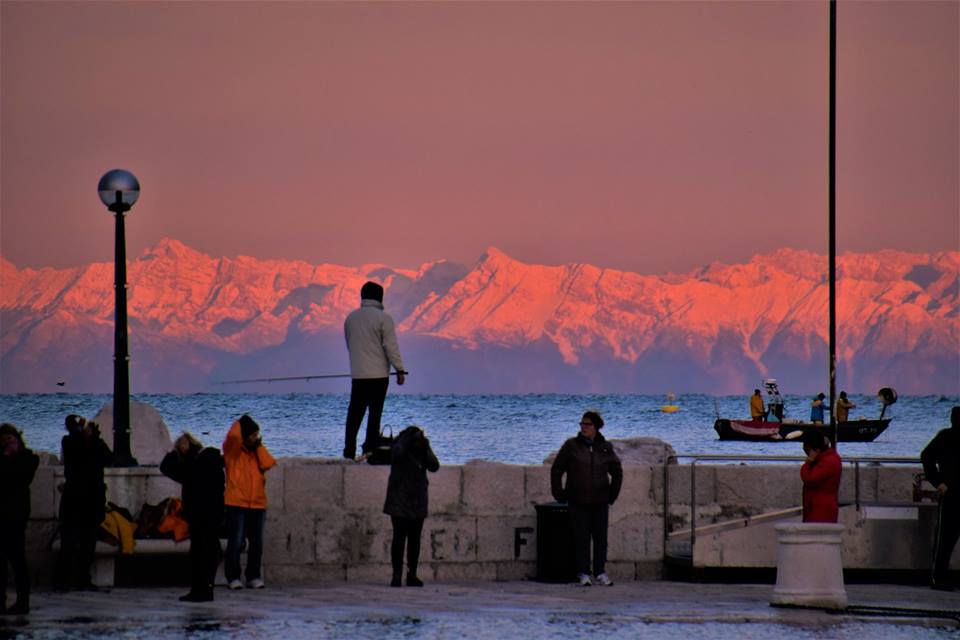January 31, 2018
A friend of mine, Jože K., whose main pleasures are exercise and desserts, was unequivocal when I asked for his favourite place to spend a vacation in Slovenia: “Strunjan is the most beautiful place in the country – for running, cycling, walking, meditating, laying on the beach, admiring the nature, and eating the creamiest ice-cream on the beach”.
And when seen from the air, he may have a point.
The coast of Slovenia is one of the sunniest parts of the country, with over 2,300 hours of sun a year and just 1,000 mm of rain. It has mild winters, and summers that are relatively cool for the Mediterranean, but still hot enough for people to live in shorts and T-shirts for much of the time, if not just swimsuits, with sunbathers a common sight on many of the area’s flat surfaces.

Sunbathers in Piran. Wikimedia: Tobin - CC by 2.0
Still, not everyone who goes to the coast likes to bake on a rock or boil on the grass, go gambling or drink and eat seafood. Some, like my friend, go with the express aim of visiting the green expanse that is Strunjan Nature Reserve, jutting out into the Adriatic between the picture postcard town of Piran and the seafood mecca of Izola, a hidden gem within a hidden gem, and so on. The ideal location for those whose hedonism drives them towards the sensual delights of physical activity in nature, with the buzz of the insects, the tweet of the birds, and the colours and scents of lush Mediterranean flora, as seen on Rtič Ronek (Cape Ronek).
The free-to-enter Strunjan Nature Reserve (Krajinski park Strunjan) has some nice hiking trails, not too challenging or long, with a 7 km route detailed here and the kind of thing to expect on foot shown in the following video.
Indeed, spend a couple of hours in Strunjan and you’ll see another side to the coast, one quite different to that on offer in the better-known parts. People come to this park – with both dry land and marine elements protected – to walk, hike, bike or run through some spectacular natural scenery, then perhaps take a dip in a bay ringed with dramatic cliffs made of the same rock that gives the local wines much of their character, and finally diving into a bowl of gelato, a well-earned treat after Primorskan exertions.

Franjo Kravos - View of the Alps from Piran
Strunjan affords visitors a clear view of the whole Slovenian coast, the longest clean stretch along the Gulf of Trieste, and you can usually see that town from the park, while on a clear day you can even spy the Alps. (It’s here we pause to note that the wealthy port of Trieste was given to Italy after the First World War, with that country somehow managing to join both global conflicts on the losing side, then switch in time to gain parts of Slovenia in victory.)
Here’s some Italians enjoying what they know as Strugnano.
One focus of the park is Mesečev zaliv (Moon bay), shown in the image at the top of this text and the one below, and a good base for exploring rock pools or leaving your things on the shore and taking a dip. The striking appearance of this bay is due to the flysch it’s made of, a sedimentary rock that dates back to the Eocene, some 56 to 33.9 million years ago.
Flysch is composed of sandstone, marl and carbonate turbidite, with erosion giving the landscape its distinct, layered appearance. However, the material, as shown below, is rather fragile in places, so take care and beware of falling rocks while walking under the cliffs, or of weak steps when on them.

Here’s a video of dog with a GoPro exploring the beach.
The watery part of the nature reserve is called Rtič Madona (Cape Madonna). As elsewhere along the coast, if you do go in the water be sure to look out for sea urchins, and consider taking along some goggles or a mask, since in addition to the fish and urchins you’ll likely spot sponges, sea cucumbers and other creatures.
Cyclists also have much to enjoy, with many paths taking you along the coast and the cliffs, as seen in the following ride.
In addition to the park, other sites to see are the much-photographed salt pans, which first appear in written records in 1274, just a few centuries after those nearby at Sečovlje.

There’s also the chance to enjoy some of the local produce, with notable products being olives and wine, although perhaps the most famous is persimmon (kaki). So important is this fruit to the area, which produces a third of the nation’s annual crop, that there’s even a persimmon festival (Praznik kakijev) in November.
And if you’ve done all that and want something slightly livelier, then the fleshpots of Izola, Piran and Portorož are not far away, as seen in the map below.
Getting to Strunjan is easy. If you prefer to let someone else drive then you can get a bus to/from Trieste, Ljubljana or Croatia, or the train to/from nearby Koper or Trieste. with links to the related timetables in the place names. There’s also the option of flying in to Portorož Airport, or getting there by sea.








